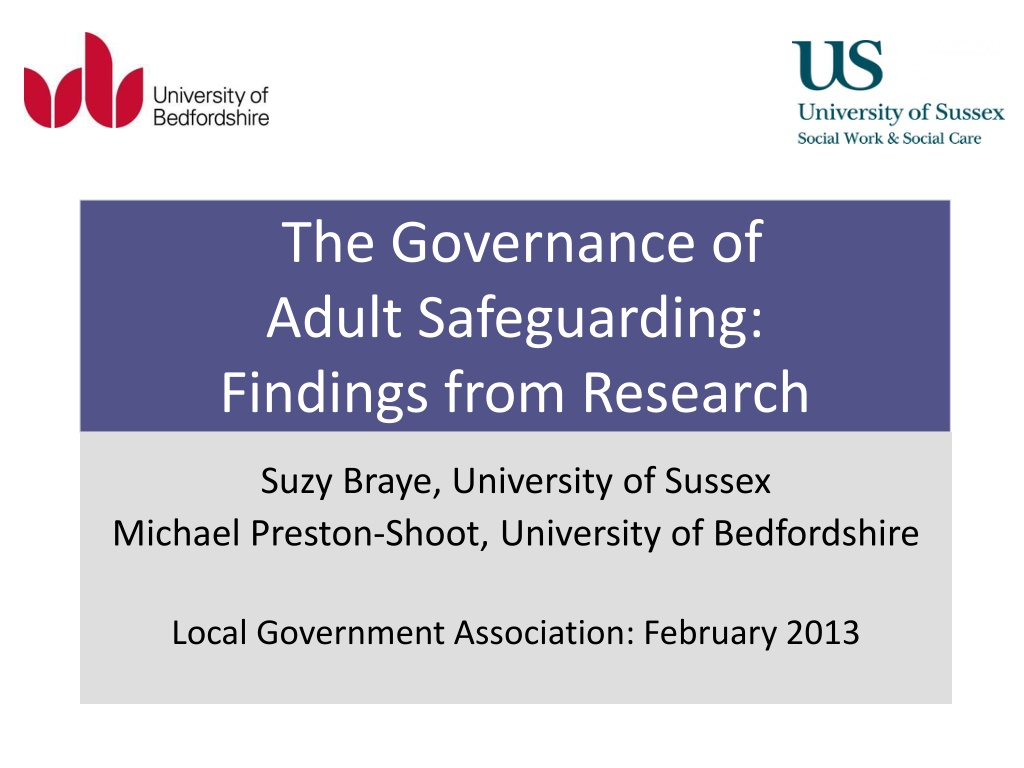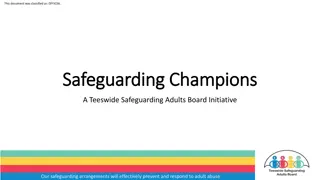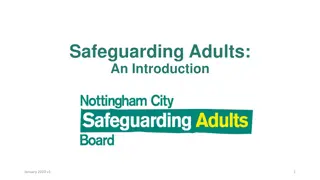Governance of Adult Safeguarding: Research Findings and Challenges
This research delves into the governance practices of adult safeguarding, focusing on the structures, coordination mechanisms, and decision-making frameworks of Safeguarding Adults Boards. It aims to identify good practices and ways in which boards practice empowerment. The study highlights the governance challenges in adult safeguarding, including the nature of the mandate, multi-agency involvement, diverse accountability routes, and debates on the task's scope. Key findings on governance arrangements cover structures, membership patterns, functions, activity scope, rules of engagement, and accountabilities.
Download Presentation

Please find below an Image/Link to download the presentation.
The content on the website is provided AS IS for your information and personal use only. It may not be sold, licensed, or shared on other websites without obtaining consent from the author. Download presentation by click this link. If you encounter any issues during the download, it is possible that the publisher has removed the file from their server.
E N D
Presentation Transcript
The Governance of Adult Safeguarding: Findings from Research Suzy Braye, University of Sussex Michael Preston-Shoot, University of Bedfordshire Local Government Association: February 2013
Our overall research aim To identify good practice in the governance of adult safeguarding through review of Safeguarding Adults Boards Governance: how an organisation or activity is directed and controlled; how responsibility and accountability are exercised Structures and coordinating mechanisms Management, power and authority Frameworks and boundaries for decision-making To identify ways in which boards practise empowerment
The governance challenge in adult safeguarding The nature of the mandate The multi agency involvement The diversity of accountability routes Debates about the nature & scope of the task
Sources of data in the research Database searches: 3163 sources/48 included 1. Literature London/Manchester 31/44 attendees 2. Workshops Individual overview (5) Practitioner focus group (1) 3. Key informants 4. Regional project work 5. Survey of SAB documents Boards, chairing & governance Participation of users and carers 47 authorities, 203 documents Submissions, websites, CQC
CQC 2009 scores on outcome 7: N=153 Total sampled = 47 (31%) All local authorities Our sample Excellently 12 8% 12 25% Well 90 59% 21 45% Adequately 45 29% 13 28% Poorly 2 1% 0 0% Not rated 4 3% 1 2% 153 100% 47 100%
Key findings on governance arrangements 3. Structures and membership patterns 4. Key functions 2. Definition and scope of their activity 5. Rules of engagement SAB 1. Purpose and mission 6. Accountabilities
1. What are boards for? What are their purpose and mission? Tension between strategic and operational purposes The balance between strategic & operational focus impacts on structure Structure influences strategic and operational capacity Strategic leadership Operational quality
Statements of shared principle Recognition of diversity; commitment to equality and fair access Recognition of and respect for human rights and dignity Promotion of independence and autonomy, choice and control Commitment to empowerment Capacity to make decisions, or best interests interventions Proportionality in containing risk Confidentiality Duty of care - a right to protection Commitment to participation
2. The scope of safeguarding The way boards express their mission is related to the question of definition and scope of safeguarding; they work more widely than definitions imply Users of services Vulnerable adults Community population
Choices of focus for engagement Individual focus Preventive work Reactive work Whole community focus
Modelling the scope Community engagement Specific initiatives to address identified harm to groups Community awareness raising Preventive Reactive Education/risk management initiatives Investigation and protection planning Individual engagement
3. Structures and membership Wide variety in size: 10 30+ Tensions between seniority and inclusion Trend for restructuring and multi-layering Sub-groups for operational efficiency: training; policies/procedures; QA Specification of commitment and contribution is common
Expectations of member agencies Designate a lead officer Ensure implementation of No Secrets, and Board expectations Provide monitoring information and an annual report to the Board Contribute to strategic direction of the board Provide clear operational guidance for staff and appropriate training Ensure robust procedures for: Recruitment and selection of staff Risk assessment Embedding safeguarding in care plans Reporting and recording Whistleblowing Responding to allegations against staff
Expectations of individual members Communication link between board and agency Monitoring compliance of the member agency Providing feedback to the board Ensuring compliance with AQ requirements Participating in and leading sub-groups Facilitating information sharing Acting as a safeguarding voice
Horizontal and vertical differentiation Safeguarding Adults Board [Strategic function] Safeguarding Adults Group [Operational function] Safeguarding Adults Board Sub- Group 1 Sub- Group 2 Sub- Group 3 Sub- Group 4
Range of sub-groups Workforce development Serious case reviews Practice development Policy & procedures Short life task & finish Practitioner liaison Wider stakeholder networks Quality assurance Locality based groups Communications & publicity Special interest groups Service users & carers
Structural links with external stakeholders Accountability links to partnerships & committees Links with other Links with other safeguarding boards SAB coordinating partnerships Links with those who need to know
Policies & procedures Review & improve practice Training strategy 4. Board functions Member agency compliance Strategic planning Performance management and QA Interagency relationships Public & professional awareness
Mechanisms for quality assurance Audit of compliance with procedures Regular reports from member agencies Commissioning and contracting Improvement action plans Audit and inspection Evaluation of training Case file audit Long term quality improvement work Monitoring of activity statistics Self evaluation by case- holders External peer review Serious case review action plans
5. Rules of engagement Chairing Rules of engagement 20%/50% independent Frequency of meetings Role descriptors Diverse reporting Attendance & Quoracy Pros & cons Divided opinions Decision-making mandate: not executive Challenge/Accountability Ownership/Responsibility Voting protocols Role of Chair
Role of the chair The role of the chair is to work: On board mission, strategy and planning On the conduct of the board s business In the interagency arena On external accountabilities and relationships On the public face of the board s activities In the regional and national arenas Leadership, Coordination, Support, Challenge
Independent chairing Perceived benefits Perceived risks Distancing of the LA from its lead role and reduction of senior LA involvement Greater degree of challenge to the safeguarding system Abdication of responsibility by key statutory agencies Exercise responsibilities without agency self-interest Fairness in holding agencies to account Lack of authority to resolve interagency politics Lack of insider knowledge of local politics Mediation of interagency power relations External credibility in the public perception Cost Essentially, transparency, challenge and scrutiny Essentially ownership, authority and resources
Developments on independent chair appointment processes Advertising and formal applications process Job description Main purpose/strategic role Accountabilities Main activities and responsibilities Person specification Education/training/qualifications Relevant knowledge Relevant experience Skills Personal qualities
Accountability of the independent chair Seldom made explicit, and is complex In reporting terms, may be to: Director of Adult Social Care Chief Executive of the Council Executive Board of the safeguarding partnership Each of these lines of accountability has pros and cons, and may compromise independence, or perceived independence
Resources Securing resources for the work of the board is a key challenge Resource position of LSCBs is believed to be clearer and more secure Lack of national performance indicator perceived as a barrier to securing LSP resources Boards tend not to have dedicated budgets (though some do) Costs often shared between the lead statutory partners; default responsibility falls to the LA Contributions from other partners may be in kind Business planning models more common as boards seek to make robust a case
6. Accountabilities Of members to the board Parallel to processes in member agencies Periodic reporting mechanisms Self regulation of the board Standards for evaluating Board performance Statements of IC s responsibilities Diversity and complexity of reporting Multi-agency engagement Complexity of stakeholder network Of the board to external bodies
Organisational structure shown with permission from the named authority
Accountability matrix rather than hierarchy Diverse forms of accountability owed to multiple stakeholders Different forms of accountability Political accountability to the body from which the board draws its power/mandate, for the ways in which it exercises that power, and the outcomes it achieves Explanatory accountability, to those to whom ones actions must be explained or justified Responsive accountability, owed to those whose views must be taken into account
Key findings on empowerment Work in progress : diverse mechanisms Principles & values: human rights, choice & control Participation in own safeguarding Post hoc feedback and evaluation Participation in board functions Community engagement: conferences, publicity, events
G vE and others [2010] The mandate for involvement in one s own safeguarding is further strengthened by judgement in G v E and others (EWHC 621 (Fam)(26 March 2010). The court was very critical of the safeguarding procedures adopted by the local authority, and in particular of key meetings held without the involvement of the individual who was the subject of the safeguarding concern, and his carer.
Facilitators of empowerment The vision and will to make it happen Support and leadership from senior staff Support and leadership from Forum participants Openness and honesty of communication Commitment to a rights based approach Commitment from the multi-agency board Creativity and imagination in ways of communicating Resources - mainly time and energy rather than money
So what does good practice in governance look like? Membership Functions Structures Checks and balances Goals and purpose Accountabilities
Good governance 1: Goals and purposes Definition of the scope of the activity Strong statement of principles Clarity of goals & explicit multiagency commitment Innovation/strategic leadership
Good governance 2: Structures Clear divisions of responsibility horizontal differentiation Mechanisms for communication between layers vertical coordination Clear focus for specific functions - vertical differentiation Explicit linking between functions horizontal coordination
Safeguarding Adults Board Safeguarding Adults Operational Group Sub-Group 2 Sub-Group 3 Sub-Group 4 Sub-Group 1
Good governance 3: Membership Rationale for inclusion Clear understanding of roles & explicit commitments Stakeholder engagement Chairing arrangements and meeting protocols Clarity on contribution of resources
Good governance 4: Functions Strategic planning & operational oversight Audit, performance management and QA A strong developmental/improvement agenda Boundary management, cross agency
Good governance 5: Accountabilities Standards for board performance Clarity about decision-making authority Clarity about accountabilities owed Links with other partnerships Explicit mechanisms for empowerment Mechanisms for representation & redress
The Future? Draft Care and Support Bill Placing LSABs on a statutory footing Power to generate resources Capacity to conduct announced and unannounced audits Will newly configured and resourced LSABs help to hold statutory and third sector organisations accountable for the care they provide? Avoiding another Winterbourne or Mid Staffordshire?
Contact details Suzy Braye Professor of Social Work University of Sussex s.braye@sussex.ac.uk Michael Preston-Shoot Dean, Faculty of Health & Social Sciences University of Bedfordshire michael.preston-shoot@beds.ac.uk























